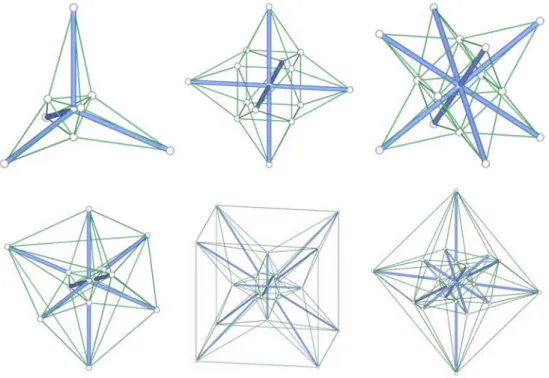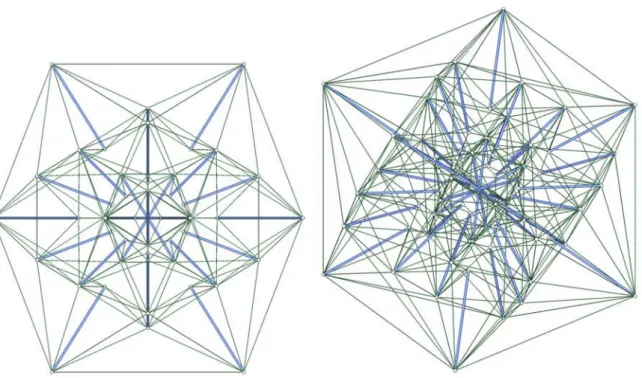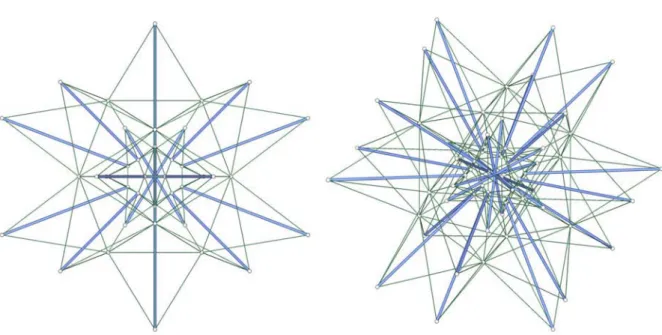Nested En
Andre *Department of Civil andaDepartment of Eng
Abstract
We present the results of a geom systems, which we name nested e by Kenneth Snelson. These “circumferential” cables, and sta stability and selfstress in relation find that internal mechanisms ne and that admissible selfstress s starting from the center. This stu class of tensegrities, which may protection systems.
Keywords: prestressed systems, tensegri 1. Introduction
Tensegrity systems have always Snelson, owing to the fact that rig Tensegrities can also be regarde Richard Buckminster Fuller. Bo property originally stated by R independently of elastic moduli infinitely large failure strength). polygons, with cables along the shown that centrosymmetric po vertices, are superstable (see [1] f We present a study on nested end systems. A nested endoskeletal arranged in concentric layers, p dimensional case. Related struct structural design of the Kent Te Figure 1, has been reported. Str balloons, according to an analog increases towards the center. For inner balloon is in tension if its pressure inside the outer balloon.
July 16-20, 20 Caitlin Mueller, Sig
Endoskeletal Prestressed Structure
drea MICHELETTI*, Giuseppe RUSCICAand Computer Science Engineering, University of Rome T Via Politecnico 1, 00133, Rome, Italy
ngineering and Applied Sciences, University of Bergamo
Dedicated to the memory
ometrical and numerical investigation on a particul d endoskeletal prestressed systems, following a ter e systems are composed by concentric laye stabilizing cables. After describing how to constr ion to connectivity, number of layers, and geomet need to be eliminated by additional cables in orde states can be determined by establishing selfs study represents a first step toward the systematic d
ay find application in robots for rough-terrain loc
grity structures, conceptual design, morphology, form finding
ys been referred to as “endoskeletal prestressed s rigid elements (bars) are inside a network of flexib rded as pressurized “balloons”, following the wel Both these analogies are seemingly connected Robert Connnelly to indicate a prestressed syst
uli and level of selfstress (assuming constituen h). In 2D, it has been shown that tensegrities co e sides, and bars along the chords, are superstable polyhedra, with cables on the edges and bars c
] for details).
endoskeletal structures, a particular class of centros al structure is composed of radial bars and “circ , plus additional stabilizing cables, as shown in
ctures have been described for the first time in [ Tensegritree, an actual construction based on the Structures of this type can also be regarded as co logy which is able to explain the result, proved in
or example, considering two balloons inside each o its internal pressure is larger than its external pr
.
2018, MIT, Boston, USA igrid Adriaenssens (eds.)
ures
e Tor Vergata
mo, Italy
ory of Kenneth Snelson
ular class of tensegrity terminology introduced yers of radial bars, struct them, we study
etry. In particular, we rder to ensure stability, lfstress layer-by-layer, c design of this special locomotion and
shock-.
systems” by Kenneth ible members (cables). ell-known analogy by ed to superstability, a
ystem which is stable ent materials to have constructed on convex ble. In 3D, it has been s connecting antipodal trosymmetric tensegrity
ircumferential” cables, in Figure 1 in a two-n [2], while itwo-n [3] the the system sketched in concentric pressurized d in [3], that the stress h other, the skin of the pressure, which is the
We conduct a geometrical and numerical investigation on selfstress and stability of systems in 2D and 3D, studying their dependence on connectivity, number of layers, and geometry. This study constitutes a first step toward the systematic design of this special class of tensegrities.
Figure 1: Connectivity and member types of the structure employed for the Kent Tensegritree [3]. Radial bars, “circumferential” cables, and stabilizing cables are shown in blue, red, and green, respectively.
Figure 2: Parallel projection and axonometric view of a three-layer nested endoskeletal system, which is obtained by starting from an octahedron as innermost polyhedron.
2. Geometry
We begin by describing one method for obtaining a nested endoskeletal system in three-dimension. Starting with a convex polyhedron (which can be regular or irregular), we can construct a tensegrity system with nodes on the vertices, cables along the edges, and radial bars connecting the vertices to an
additional node at the center of the polyhedron. This corresponds to the innermost endoskeletal system. The next step is to add a node at the centroid of each face of the polyhedron. Each of these nodes is connected to the vertices of the corresponding face with cables. A radial bar is then added for each of such faces, with one endpoint at the node on the face centroid, and the other endpoint at the vertex of a second, new polyhedron, with cables along the edges, which is the dual of the starting polyhedron. Additional cables connect each of the vertices of the dual polyhedron with the vertices of the corresponding face on the primal one. A prestressed structure can then be obtained by elongating bars, considering cables with a linearly elastic behavior. As a consequence of bars elongation, the nodes at the centroids of the primal faces are pushed inward. This procedure can then be repeated by adding a new set of nodes at the face centroids of the second polyhedron, and continuing in a similar way. We remark that structures obtained according to this method do not possess internal mechanisms. Figure 2 shows a three-layer structure obtained with this method by starting with a regular octahedron (the second and third polyhedra are respectively a cube and a octahedron).
There are multiple ways for obtaining nested endoskeletal system. For example, another method consists in replacing a polyhedron with the corresponding stellated polyhedron (Figure 3). Another possibility is to associate more than one radial bars to each face of the primal polyhedron, with suitable sets of additional cables.
Figure 3: Some tensegrity balloons obtained from stellated polyhedra. Systems at the top of this figure are substructures at the center of corresponding systems at the bottom.
3. Stability
We discuss here the stability of nested endoskeletal systems. First, we observe that, in two-dimensions, a system composed by a polygon with (tensioned) cables along the edges, and (compressed) radial bars connecting the vertices to a concentric circular rigid body (shown in Figure 4, left) is not a stable structure. This can be seen by recalling the notion of prestress-stability: each internal mechanism should be associated with a geometric load which spends positive work. In the present case, there is only one internal mechanism which is the relative rotation between the polygon and the rigid body, and the associated geometric load spends negative work, as depicted in Figure 4 (right). Therefore, this system is not prestress-stable. Similarly, in three-dimensions, it can be seen that
a system composed by a triangulated polyhedron with cables along the edges, and radial bars connecting the vertices to a concentric spherical rigid body is not prestress-stable.
Figure 4: Left: a two-dimensional system with cables along the sides of a polygon, and radial bars connecting the vertices to a concentric circular rigid body. Right: graphical construction of the geometric load (small red arrow)
associated with a small relative rotation between the polygon and the rigid body.
Now, let us consider the two-dimensional example shown in Figure 5. The outer polygon is connected to the inner polygon not only by radial bars, but also by radial cables. In the centrosymmetric configuration shown in Figure 5 (left), the system is not prestress-stable; however, by elongating the bars we can reach the prestressed-stable configuration shown in Figure 5 (right). It is worth noticing that the mirror image of the configuration in Figure 5 (right) is also prestress-stable, and this system constitute an example of bistable nested endoskeletal system. In Section 4, we will describe a three-dimensional system consisting of two rigid concentric polyhedra, connected by radial bars and radial cables, which happens to be prestress-stable in a centrosymmetric configuration.
Figure 5: A two-layer system in two dimensions. Left: centrosymmetric configuration. Right: a prestress-stable configuration and the associated selfstress state. The values of the axial forces are rescaled to a value of
maximum compression equal to -100.
The previous example shows that adding radial cables stabilize the rotational internal mechanisms of nested endoskeletal systems. However, in order to ensure stability in centrosymmetric configurations, more cables need to be added to the system until all internal mechanisms are removed.
Lastly, regarding superstability, our numerical computations show that none of the systems studied possess this property.
4. Self-stress
The systems described here possess a large number of independent states of selfstress, but only a limited subset of those selfstress states are admissible, that is, the stress is positive in cables and negative in bars. In particular, if the selfstress is established in the structure by elongating bars, some cables can go slack. A simple way to find an admissible selfstress state is to establish the selfstress layer-by-layer, starting from the innermost polyhedron.
We consider two examples. The first one consists of a three-layer system based on the regular icosahedron, which is obtained with the first method described in Section 2. Figure 6 shows two views of this system, while Figure 7 depicts an admissible selfstress state.
The second one is a two-layer system consisting of the first stellation of the dodecahedron (the inner polyhedron) connected to the first stellation of the icosahedron (the outer polyhedron) by radial bars and radial cables only. Figure 8 shows two views of this system, while Figure 9 depicts an admissible selfstress state. This system has three internal mechanisms, corresponding to the rigid relative rotations between the two polyhedra, and it is prestress-stable.
Figure 6: Parallel projection and axonometric view of a three-layer nested endoskeletal system, which is obtained by starting from an icosahedron as innermost polyhedron.
Figure 7: An admissible selfstress state for the system shown in Figure 5. The values of the axial forces are rescaled to a value of maximum compression equal to -100.
Figure 8: Parallel projection and axonometric view of a two-layer nested endoskeletal system, consisting of the first stellation of the dodecahedron connected by radial bars and radial cables to the first stellation of the
Figure 9: An admissible selfstress state for the system shown in Figure 8. The values of the axial forces are rescaled to a value of maximum compression equal to -100.
References
[1] R. Connelly, Tensegrities and Global Rigidity, technical report, Department of Mathematics, Cornell University, 2009..
[2] H. Tamai and M. Elnimeiri, Semi-triangulated and free-standing tensegrity domes: exploring cablestrut configurations for tensegrity domes based on structural performances, Proceedings of
IASS Symposium / APCS Conference 2006, Beijing, China, 2006.
[3] P. Daro, D. Gray, S. Guest, A. Micheletti, P. Winslow, “The Kent Tensegritree Project”,
![Figure 1: Connectivity and member types of the structure employed for the Kent Tensegritree [3]](https://thumb-eu.123doks.com/thumbv2/123dokorg/7601284.114364/2.892.319.579.232.496/figure-connectivity-member-types-structure-employed-kent-tensegritree.webp)




